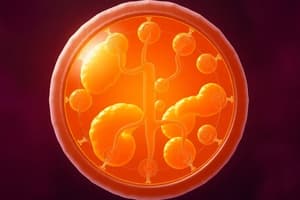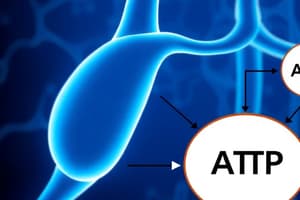Podcast
Questions and Answers
What happens to pyruvate when oxygen is available?
What happens to pyruvate when oxygen is available?
- It undergoes fermentation.
- It is converted to lactate.
- It enters the mitochondria for aerobic respiration. (correct)
- It is converted directly to glucose.
What molecule does acetyl CoA bond with before entering the Krebs Cycle?
What molecule does acetyl CoA bond with before entering the Krebs Cycle?
- ADP
- NAD+
- Coenzyme A (CoA) (correct)
- FAD
How many molecules of NADH are produced from one molecule of acetyl CoA during the Krebs Cycle?
How many molecules of NADH are produced from one molecule of acetyl CoA during the Krebs Cycle?
- 4
- 5
- 3 (correct)
- 2
What is the primary function of the electron transport chain?
What is the primary function of the electron transport chain?
Who discovered the Krebs Cycle, and what recognition did he receive?
Who discovered the Krebs Cycle, and what recognition did he receive?
What is the role of oxygen in the electron transport chain?
What is the role of oxygen in the electron transport chain?
What process occurs in the inner mitochondrial membrane during aerobic cellular respiration?
What process occurs in the inner mitochondrial membrane during aerobic cellular respiration?
What is generated when hydrogen ions move through ATP synthase?
What is generated when hydrogen ions move through ATP synthase?
What is formed as a by-product when oxygen accepts electrons in the ETC?
What is formed as a by-product when oxygen accepts electrons in the ETC?
What is necessary for aerobic cellular respiration to occur?
What is necessary for aerobic cellular respiration to occur?
What is the primary purpose of cellular respiration in cells?
What is the primary purpose of cellular respiration in cells?
Which molecule is produced as a byproduct of aerobic respiration?
Which molecule is produced as a byproduct of aerobic respiration?
Which process occurs in the mitochondria?
Which process occurs in the mitochondria?
How much ATP is produced through anaerobic respiration?
How much ATP is produced through anaerobic respiration?
What is the role of NADH and FADH in cellular respiration?
What is the role of NADH and FADH in cellular respiration?
What is the main difference between aerobic and anaerobic respiration?
What is the main difference between aerobic and anaerobic respiration?
In which part of the cell does glycolysis occur?
In which part of the cell does glycolysis occur?
Which organism primarily relies on fermentation processes?
Which organism primarily relies on fermentation processes?
What is the main purpose of glycolysis?
What is the main purpose of glycolysis?
Which of the following is NOT a characteristic of glucose that makes it suitable as an energy supply molecule?
Which of the following is NOT a characteristic of glucose that makes it suitable as an energy supply molecule?
What is the net gain of ATP produced during glycolysis?
What is the net gain of ATP produced during glycolysis?
What happens to NAD+ during glycolysis?
What happens to NAD+ during glycolysis?
Which of the following accurately describes the Kreb's cycle?
Which of the following accurately describes the Kreb's cycle?
During which stage of aerobic respiration is glucose first broken down?
During which stage of aerobic respiration is glucose first broken down?
Which of these is a high-energy compound produced at the end of glycolysis?
Which of these is a high-energy compound produced at the end of glycolysis?
What type of reaction is glycolysis categorized as?
What type of reaction is glycolysis categorized as?
What happens during anaerobic respiration when oxygen is unavailable?
What happens during anaerobic respiration when oxygen is unavailable?
Which of the following best describes fermentation?
Which of the following best describes fermentation?
What is the main by-product of ethanol fermentation?
What is the main by-product of ethanol fermentation?
During lactate fermentation, what is pyruvate converted into?
During lactate fermentation, what is pyruvate converted into?
Why do muscles experience cramps after intense exercise?
Why do muscles experience cramps after intense exercise?
Flashcards
Cellular Respiration
Cellular Respiration
The process where plants and animals break down glucose to release energy.
Aerobic Respiration
Aerobic Respiration
A type of cellular respiration that requires oxygen and produces a high energy yield (36 ATP).
Anaerobic Respiration
Anaerobic Respiration
A type of cellular respiration that does not require oxygen and produces less energy (2 ATP).
Glycolysis
Glycolysis
Signup and view all the flashcards
Krebs Cycle
Krebs Cycle
Signup and view all the flashcards
Mitochondria
Mitochondria
Signup and view all the flashcards
ATP
ATP
Signup and view all the flashcards
Fermentation
Fermentation
Signup and view all the flashcards
Pyruvate Fate
Pyruvate Fate
Signup and view all the flashcards
Acetyl CoA
Acetyl CoA
Signup and view all the flashcards
Electron Transport Chain
Electron Transport Chain
Signup and view all the flashcards
Electron Transport Chain (ETC)
Electron Transport Chain (ETC)
Signup and view all the flashcards
ATP Synthase
ATP Synthase
Signup and view all the flashcards
Chemiosmosis
Chemiosmosis
Signup and view all the flashcards
Final Electron Acceptor (ETC)
Final Electron Acceptor (ETC)
Signup and view all the flashcards
Aerobic Respiration Stages
Aerobic Respiration Stages
Signup and view all the flashcards
Glucose's role in energy
Glucose's role in energy
Signup and view all the flashcards
Aerobic Cellular Respiration
Aerobic Cellular Respiration
Signup and view all the flashcards
Glycolysis ATP net gain
Glycolysis ATP net gain
Signup and view all the flashcards
ATP's importance
ATP's importance
Signup and view all the flashcards
Pyruvate
Pyruvate
Signup and view all the flashcards
Three stages of aerobic respiration
Three stages of aerobic respiration
Signup and view all the flashcards
What is anaerobic respiration?
What is anaerobic respiration?
Signup and view all the flashcards
What are electron acceptors in anaerobic respiration?
What are electron acceptors in anaerobic respiration?
Signup and view all the flashcards
What is fermentation?
What is fermentation?
Signup and view all the flashcards
What happens during lactate fermentation?
What happens during lactate fermentation?
Signup and view all the flashcards
What is ethanol fermentation?
What is ethanol fermentation?
Signup and view all the flashcards




